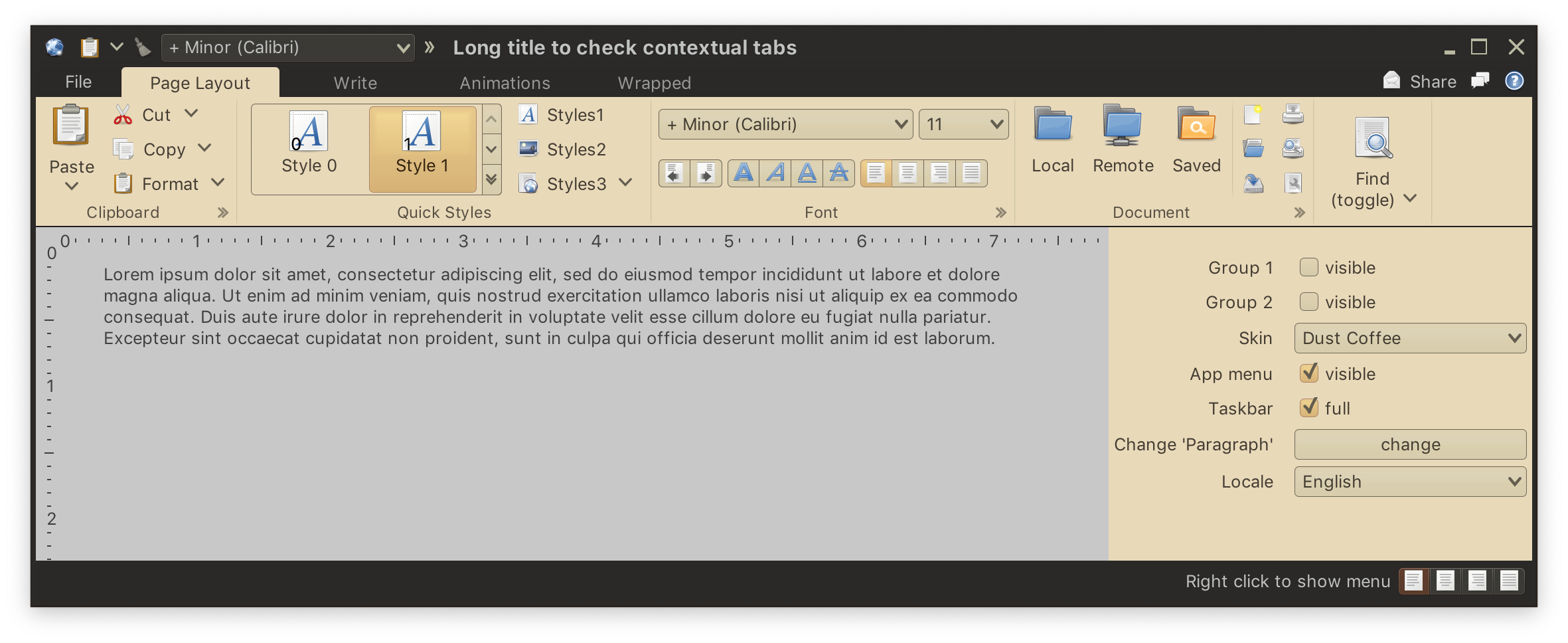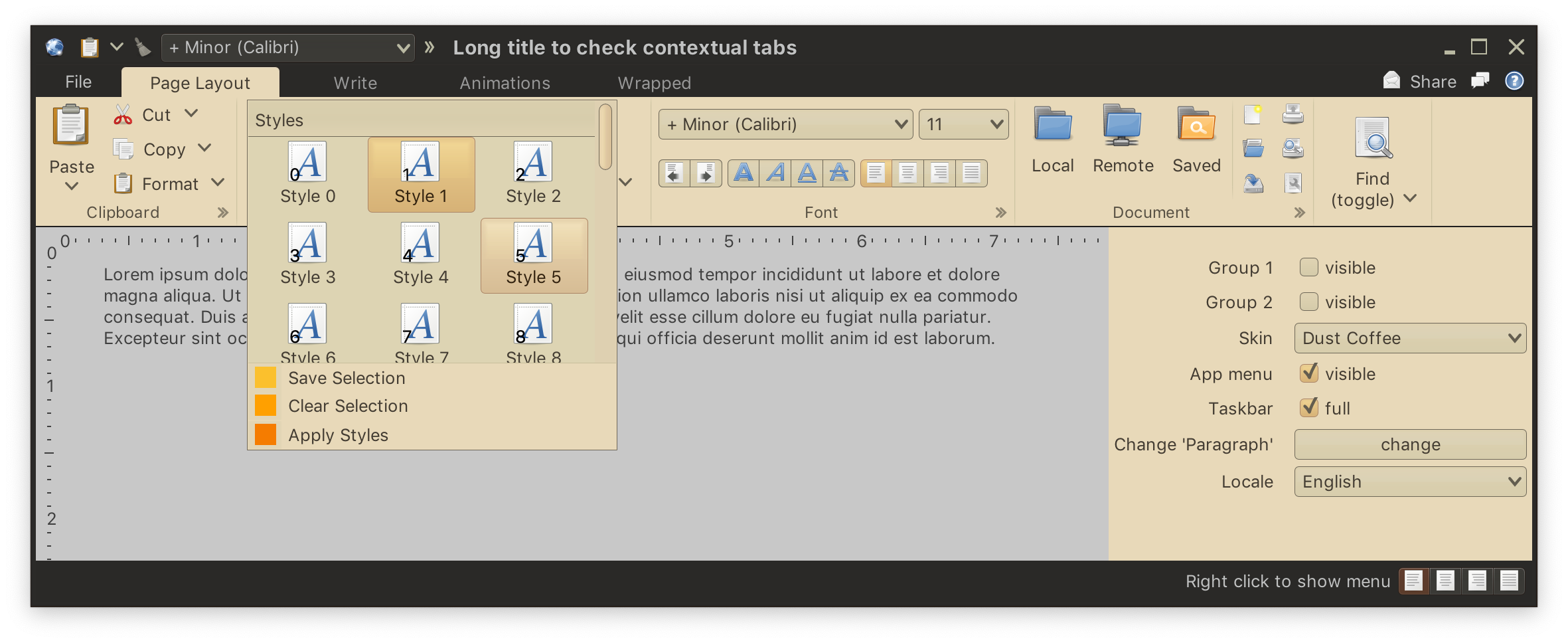As the following sections will take a deep dive into how the ribbon is built bottom-up, here is a skeleton overview of how the ribbon is built top-down.
The JRibbonFrame is the only officially supported way to use the Radiance ribbon component. Its implementation enforces that the ribbon is always at the BorderLayout.NORTH location, throwing IllegalArgumentException on attempts to set a custom layout manager, add another component at BorderLayout.NORTH, remove the ribbon component, set a custom menu bar, content pane or any other operation that interferes with the intended hierarchy of this frame.
Call JRibbonFrame.getRibbon() to get a JRibbon object that represents the ribbon itself.
Ribbon tasks (see the section below) are added with JRibbon.addTask(RibbonTask) API. Contextual task groups are added with JRibbon.addContextualTaskGroup(RibbonContextualTaskGroup) API.
Ribbon taskbar content is added with the following APIs:
- Regular command (projections) with
JRibbon.addTaskbarCommand(Command)API. - Component projections with
JRibbon.addTaskbarComponent(ComponentProjection)API. - Ribbon galleries represented as dropdown buttons with
JRibbon.addTaskbarGalleryDropdown(RibbonGalleryProjection)API. - Links to application menu content represented as command projections with
JRibbon.addTaskbarAppMenuLink(Command)API.
Anchored commands are added with JRibbon.addAnchoredCommand(CommandButtonProjection) API.
Application menu content is set with JRibbon.setApplicationMenuCommand(RibbonApplicationMenuCommandButtonProjection) API.
Contextual menu listener is set with JRibbon.setOnShowContextualMenuListener(OnShowContextualMenuListener) API.
Each ribbon task is represented by the RibbonTask class. It provides constructors to initialize the task content with the task title and the list of the task's bands:
RibbonTask pageLayoutTask = new RibbonTask(
resourceBundle.getString("PageLayout.textTaskTitle"), clipboardBand,
quickStylesBand, fontBand, documentBand, findBand);The AbstractRibbonBand is the base class for ribbon bands. There are two types of bands - general and flow.
A flow band can be seen in the screenshot above in the middle of the ribbon - the "Font" band with two comboboxes in the first row and three command strips in the second row. When the ribbon is resized and horizontal space is reduced, a flow band can switch from two-row to three-row layout.
To create a new flow band, use one of the constructors of the JFlowRibbonBand class:
JFlowRibbonBand fontBand = new JFlowRibbonBand(
resourceBundle.getString("Font.textBandTitle"), Preferences_desktop_font.factory(),
new ExpandActionListener());To add content to a flow band, use JFlowRibbonBand.addFlowComponent() APIs:
fontBand.addFlowComponent(new RibbonComboBoxProjection(this.fontComboBoxModel,
ComponentPresentationModel.builder().setKeyTip("SF").build()));
CommandStripProjection indentStripProjection = new CommandStripProjection(
new CommandGroup(indentLeft, indentRight),
CommandStripPresentationModel.withDefaults());
fontBand.addFlowComponent(indentStripProjection);All the other bands in the screenshot above are general bands. A general band can host command projections, component projections and in-ribbon galleries.
The "Clipboard" band in the screenshot above hosts four command projections - Paste, Cut, Copy and Format. The first is configured to have TOP priority and is displayed in BIG presentation state. The other three are configured to have MEDIUM priority. When there is enough horizontal space, each one is displayed in 'MEDIUM' presentation state, and the overall layout is a vertical stack of three buttons. When horizontal space is reduced, these buttons can switch to the SMALL presentation state.
To add a command (projection) to a general ribbon band, use the JRibbonBand.addRibbonCommand() API:
clipboardBand.addRibbonCommand(
Command.builder().setText(resourceBundle.getString("Cut.text"))
.setIconFactory(Edit_cut.factory())
.setAction(commandActionEvent -> System.out.println("Cut!"))
.setActionRichTooltip(RichTooltip.builder()
.setTitle(resourceBundle.getString("Cut.text"))
.addDescriptionSection(resourceBundle
.getString("Cut.tooltip.actionParagraph1"))
.build())
.setSecondaryContentModel(this.popupMenuContentModel)
.build()
.project(CommandButtonPresentationModel.builder()
.setPopupKeyTip("X")
.setTextClick(TextClick.ACTION)
.build()),
JRibbonBand.PresentationPriority.MEDIUM);To add a component projection to a general ribbon band, use the JRibbonBand.addRibbonComponent() API:
showHideBand.addRibbonComponent(new RibbonCheckBoxProjection(
RibbonCheckBoxContentModel.builder()
.setText(resourceBundle.getString("Gridlines.text"))
.build(),
ComponentPresentationModel.builder().setKeyTip("SG").build()));The "Quick Styles" band shows an in-ribbon gallery. In-ribbon galleries are configured to display a certain (usually small) number of selections, with a vertical strip right next to them to scroll the selections inline up and down, and display the available selections in a larger popup:
To add an in-ribbon gallery to a general ribbon band, use the JRibbonBand.addRibbonGallery() API:
RibbonGalleryProjection quickStylesGalleryProjection =
new RibbonGalleryProjection(this.styleGalleryContentModel,
RibbonGalleryPresentationModel.builder()
.setPreferredVisibleCommandCounts(stylesGalleryVisibleCommandCounts)
.setPopupLayoutSpec(new MenuPopupPanelLayoutSpec(3, 3))
.setCommandPresentationState(JRibbonBand.BIG_FIXED_LANDSCAPE)
.setExpandKeyTip("L")
.build());
quickStylesBand.addRibbonGallery(quickStylesGalleryProjection,
JRibbonBand.PresentationPriority.TOP);The AbstractRibbonBand.setResizePolicies(List<RibbonBandResizePolicy>) API controls what happens when the ribbon is resized horizontally, and how the available horizontal space is distributed among the ribbon band content in the currently selected ribbon task. Here's an example of configuring a ribbon band with two built-in resize policies:
List<RibbonBandResizePolicy> resizePolicies = new ArrayList<>();
resizePolicies.add(new CoreRibbonResizePolicies.Mirror(clipboardBand));
resizePolicies.add(new CoreRibbonResizePolicies.Mid2Low(clipboardBand));
clipboardBand.setResizePolicies(resizePolicies);Continue to the ribbon band command projections.

